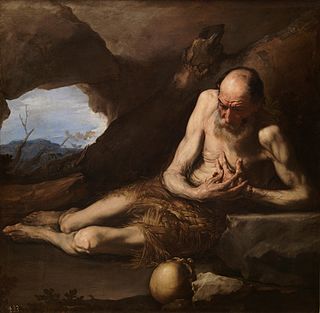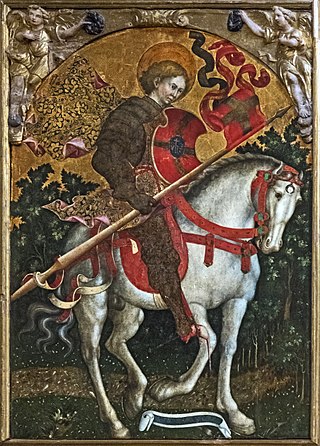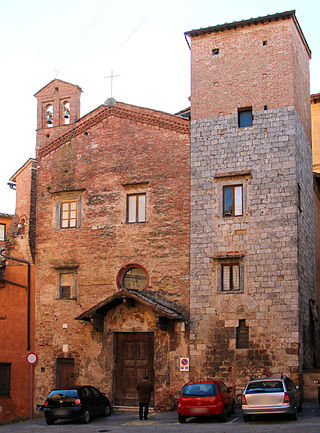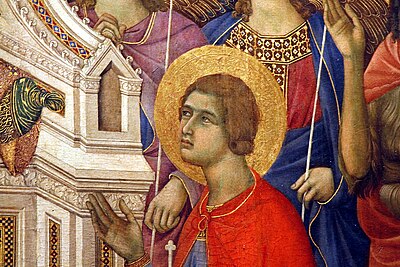
Caterina di Jacopo di Benincasa, TOSD, known as Catherine of Siena, was an Italian Catholic mystic and pious laywoman who engaged in papal and Italian politics through extensive letter-writing and advocacy. Canonized in 1461, she is revered as a saint and as a Doctor of the Church due to her extensive theological authorship. She is also considered to have influenced Italian literature.

The Catacombs of Rome are ancient catacombs, underground burial places in and around Rome, of which there are at least forty, some rediscovered only in recent decades.

Saint Valentine was a 3rd-century Roman saint, commemorated in Western Christianity on February 14 and in Eastern Orthodoxy on July 6. From the High Middle Ages, his feast day has been associated with a tradition of courtly love. He is also a patron saint of Terni, epilepsy and beekeepers. Saint Valentine was a clergyman – either a priest or a bishop – in the Roman Empire who ministered to persecuted Christians. He was martyred and his body buried on the Via Flaminia on February 14, which has been observed as the Feast of Saint Valentine since at least the eighth century.
Cyriacus, sometimes Anglicized as Cyriac, according to Christian tradition, is a Christian martyr who was killed in the Diocletianic Persecution. He is one of twenty-seven saints, most of them martyrs, who bear this name, of whom only seven are honoured by a specific mention of their names in the Roman Martyrology.

Paul of Thebes, commonly known as Paul the First Hermit or Paul the Anchorite, was an Egyptian saint regarded as the first Christian hermit and grazer, who was claimed to have lived alone in the desert of Thebes, Roman Egypt from the age of sixteen to the age of one hundred and thirteen years old. He was canonized in 491 by Pope Gelasius I, and is venerated as a saint by the Catholic Church, Eastern Orthodox Church, and Oriental Orthodox Churches.

Prisca was a young Roman woman allegedly tortured and executed for her Christian faith. The dates of her birth and death are unknown. She is revered as a saint and martyr in Eastern Orthodoxy, by the Catholic Church, and in the Anglican Communion.

Crescentius the Elder, also known as Crescenzio de Theodora, was a politician and aristocrat in Rome who played a part in the papal appointment.

Crescentius the Younger, son of Crescentius the Elder, was a leader of the aristocracy of medieval Rome. During the minority of Holy Roman Emperor Otto III, he declared himself Consul of Rome and made himself de facto ruler of Rome. After being deposed, he led a rebellion, seized control of Rome, and appointed an antipope, but the rebellion failed and Crescentius was eventually executed.

Saint Zenobius (337–417) is venerated as the first bishop of Florence. His feast day is celebrated on May 25.

Saint Chrysogonus is a saint and martyr of ancient Rome venerated by the Catholic Church and the Eastern Orthodox Church.

Saint Praxedes, called "a Roman maiden", was a saint and virgin who lived in the Roman Empire during the 2nd century. Along with her sister, Saint Pudentiana, she provided for the poor and gave care and comfort to persecuted Christians and martyrs. Her veneration began in the 4th century and many churches have been dedicated to her.

Felicitas of Rome, also anglicized as Felicity, is a saint numbered among the Christian martyrs. Apart from her name, the only thing known for certain about this martyr is that she was buried in the Cemetery of Maximus, on the Via Salaria on a 23 November. However, a legend presents her as the mother of the seven martyrs whose feast is celebrated on 10 July. The Eastern Orthodox Church celebrates their martyrdom on 25 January.

Saint Anthimus of Rome, or Sant'Antimo in Italian, is a Christian saint. His life is largely composed of legend. He is said to have been born in Bithynia. A Christian priest, he was imprisoned for his beliefs at the time of the Emperors Diocletian and Maximian. His feast day is May 11.

Saint Caesarius of Terracina was a Christian martyr. The church of San Cesareo in Palatio in Rome bears his name. He is venerated as a saint in the Eastern Orthodox Church and Roman Catholic Church, with a feast day on 1 November.
Saint Getulius is venerated together with Amantius (Amancius), Cerealus (Caerealis), and Primitivus as a Christian martyr and saint. They are considered to have died at Gabii. According to tradition, Getulius was the husband of Saint Symphorosa. Getulius is a name meaning "of the Gaetuli", which was a tribe of North Africa.

Eleutherius, also written as Eleutherus, Eleuterus and Eleftherios; sometimes called Liberalis or Liberator, the former transliterations and the latter translations of his and his mother Antia are venerated as Christian saints and martyrs in Greece and Albania.

Santi Vito e Modesto is a Roman Catholic church, and appears to have two facades, a 20th-century marble facade on Via Carlo Alberto, but a rustic brick older entrance, in reality the apse, on the Via San Vito in the Rione Esquilino of Rome, Italy. It has also been called Santi Vito, Modesto e Crescenzia. It is located in the Rione Esquilino, adjacent to the Servian Wall, near the former Monastery of the Viperesche.

Santa Maria in Provenzano, or the Insigne Collegiata di Santa Maria in Provenzano, is a late-Renaissance-Baroque style, Roman Catholic, collegiate church in Piazza Provenzano Salvani, in the Terza Camollia, just southwest of the basilica of San Francesco, in the city of Siena, region of Tuscany, Italy. This Marian shrine was built around a 14th-century terracotta icon of the Madonna, which was credited with miracles. The Palio of Siena takes place on the day of veneration of this Marian devotion.

The Church of the Jail of Sant'Ansano, Italian: Chiese delle Carceri di Sant'Ansano, also known as the Chapel or Oratory of Sant'Ansano in Castelvecchio, is a small, medieval, Roman Catholic religious building located on via Tommaso Pendola in the Terzo di Città of the city of Siena, region of Tuscany, Italy. Adjacent to the tower is the former Istituto Santa Teresa.

The church of Santa Galla was a church in Rome (Italy), in the Rione Ripa, on the road that connected Piazza Montanara with Piazza della Bocca della Verità. Both the church and the square in front of it were destroyed between 1928 and 1930 for the construction of the first stretch of Via del Mare ; the furnishings and the altar were relocated to the new church of Santa Galla at Garbatella, built in 1940.
















